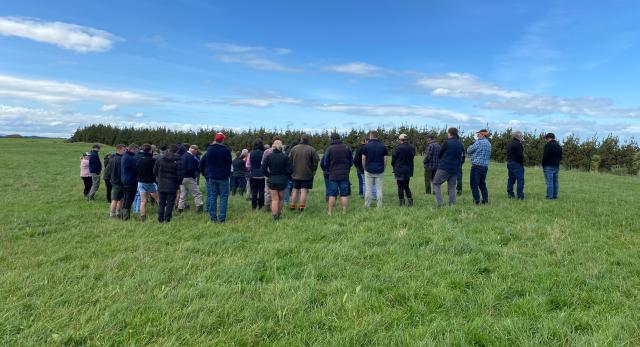Beef + Lamb New Zealand (B+LNZ) recently hosted the B+LNZ 150 Hogget Mating and Lambing Action Group meeting in Waimatuku, Southland.

Drawing over 80 farmers, the day revolved around the Hogget 150 Action Group, made up of farmers from across Southland and Otago. They shared experiences from the past six years working together to optimise hogget lambing.
Deane Carson, facilitator and Agribusiness Farm Advisor, kicked off the event by delving into client trends, comparing hogget lambing practices. The data revealed differences in production, with properties mating hoggets having a 19kgCW/ha advantage over properties not mating their hoggets.
His database combined with assumptions of a $6/kgCW lamb price found an additional $114/ha for those farmers that mated hoggets. That was despite a lower stocking rate for those farms that mate hoggets. An interesting feature of those farms that mated hoggest was a higher lamb growth rate. Deane speculated that this may be a result of feeding ewe lambs better to meet mating goals. All lambs slaughtered grew 18gms/day more when hogget lambing was undertaken.
A separate Gross margin analysis assumed mated hoggets scanned 110%, and achieve 80% lambing survival to sale (s.t.s) found returns of 22 cents to 30 cents per kilogram of drymatter. Deane noted that these returns were higher than the rest of the farm system, reinforcing the point that hogget lambing can be a path to higher returns.
Following this, a panel of members from the Hogget 150 Action Group discussed on-farm processes and health targets that contributed to successful hogget mating and lambing.
The group also outlined their yearly cycles (see below), sharing successes, challenges, and future plans. Key insights included shearing dates, ram ratios, and weaning strategies.
Group member Pete Thompson says, “It was fantastic to see a lot of younger farmers come along and most of them are lambing hoggets.”
“I really enjoyed the farmer panel. We’re all doing things differently (depending on our locations), yet getting similar results,” he says.
The day ended with a farm tour of Ashley and Ryan Lester and Chris Anderson’s properties where the hosts shared information about their own hogget mob including life cycle, key factors that drive a successful hogget mating and lambing, challenges and plans moving forward.
Hannah Blakely, B+LNZ’s Lead Extension Manager South Island attended the event. She says, “The group have so many golden nuggets of information to share. Their efforts over the past six years show the power of working together and sharing learnings to help each other enhance farm practices and profitability.”
B+LNZ would like to thank Rabobank who sponsored the event.
About the Hogget 150 Action Group
The Hogget 150 Action Group originated as part of the Red Meat Profit Partnership (RMPP) in 2018 and continued post-RMPP. The diverse group spans Southland and Otago, exploring geographic influences on hogget lambing outcomes.
With member hogget numbers ranging from 500 to over 3,000, the group focuses on achieving a 100g/day growth rate in hoggets in the winter. Regular meetings involve farm visits, knowledge exchange, and healthy competition to improve hogget performance.
“While no one in the group has hit the target of 150% lambing yet, we have all learned skills to improve our hogget performance, setting us in the right direction,” says Pete.
Hogget Mating Action Group Members:
- Bevan Hopcroft
- Geordie Eade
- Ken Campbell
- Ryan Shaw
- Peter Thomson
- Brad McPherson
- Reuben Hopcroft
- Chris Anderson
- Andrew Welsh
- Hayden Peter
- Hamish Knowles
- Hamish Wilson
B+LNZ Action Group evaluation shows positive impact on farm businesses
A comprehensive evaluation of the B+LNZ Action Group approach, done by B+LNZ working with Scarlatti, is helping shape B+LNZ’s new Extension Strategy and future delivery models.
The evaluation showed that Action Groups have had a profoundly positive impact on farm businesses by strengthening connections, boosting farmer confidence to make on-farm changes and has a high return on investment for industry profitability.
Learn more and view key findings in this article.
B+LNZ 150 Hogget Action Group yearly cycle
Key points – 150 Hogget Action Group Yearly Cycle:
- End of January: identify and select replacement ewe lambs. Ewe lambs selection – most keeping twins and triplets as ewe lamb replacement to take advantage of heavier singles at works.
- End of January/end March: Majority of the group shear replacement ewe lambs in mid-February. Preferential feeding bottom end of replacements. Put out teaser rams or rams with a no-mate harness for approx. 60 days.
- Mid-end March: Final pick of replacement ewe lambs. Campylobacter and toxoplasmosis vaccine for all animals and consider iodine and selenium supplementation.
- April: Feed very well for the first three weeks and then begin the pull back with possible break feeding during the last week of April.
- May: Rams out – more the merrier (1 to 30/40). Group is tending to lean towards using a Dorper ram as it tends to be hardy and higher survivability.
- Important mating weight to be 50+kgs with a minimum of 45kg.
- Mating periods – 1st cycle 9-10 days and 2nd cycle – 10-14 days.
- June/July: Investigate using all grass wintering and aim to gain weight over this period.
- Scan early to give yourself options – dries either slowdown or kills.
- August: Some members pre lamb shear or small belly crutch
- September: Pre-lamb vaccination (5 in 1) and long-acting drench. Preferential feed twin bearing hoggets and keep singles behind a wire until lambing.
- Lambing: set stock twins at lambing similar to ewes but well sheltered paddocks and closer to the shed. Set stock singles heavier.
- October/November: Ensure all hoggets are well fed and graze alongside cattle for pasture management.
- December: Aim to wean before Christmas and keeping hoggets feed managed post weaning.
- January: Potential to drench lighter hoggets and condition score.